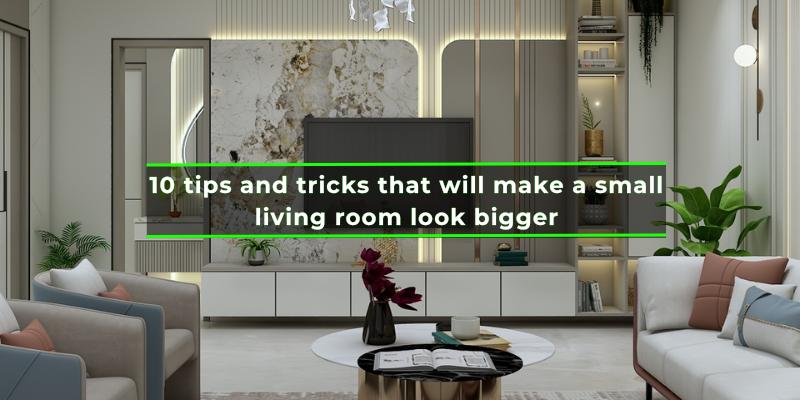Are you struggling with a tiny living room? You are not alone. Many people face the challenge of making a small space feel larger. The good news is, there are simple tips and tricks that can help. By using smart design choices, clever furniture arrangements, and a few visual tricks, you can transform your living room.
This not only improves the look but also enhances the feel of the space. Ready to learn more? Let’s dive in and discover how to make your small living room look bigger!
Opt For Light Colors
Decorating a small living room can be a challenge. Using light colors can make a huge difference. Light colors can create the illusion of more space. They reflect more light, making the room brighter and more open.
Choosing The Right Palette
Selecting the perfect color palette is crucial. Light colors such as white, beige, and light gray work wonders. These colors help to open up the space. They make the room feel airy and spacious.
You can also consider pastel shades. Soft blues, greens, and pinks can add a touch of color without overwhelming the room. These hues are soothing and can make the space more inviting.
|
Color |
Effect |
|---|---|
|
White |
Maximizes light, creates a clean look |
|
Beige |
Adds warmth, keeps space open |
|
Light Gray |
Modern feel, makes room appear larger |
|
Pastel Blue |
Calming, adds a hint of color |
|
Pastel Green |
Refreshing, enhances natural light |
|
Pastel Pink |
Soft, adds warmth without clutter |
Impact Of Light Shades
Light shades have a significant impact on a small living room. They help to reflect natural light. This makes the space feel brighter and more open. Light colors can also create a sense of continuity.
Using the same light colors on walls, furniture, and decor can unify the space. It avoids visual breaks that can make the room feel cramped. Consider a light-colored sofa and curtains. Pair them with light walls to enhance the effect.
Adding mirrors can further amplify the light. Mirrors reflect both natural and artificial light. This makes the room appear larger and more inviting. Position mirrors opposite windows for the best effect.
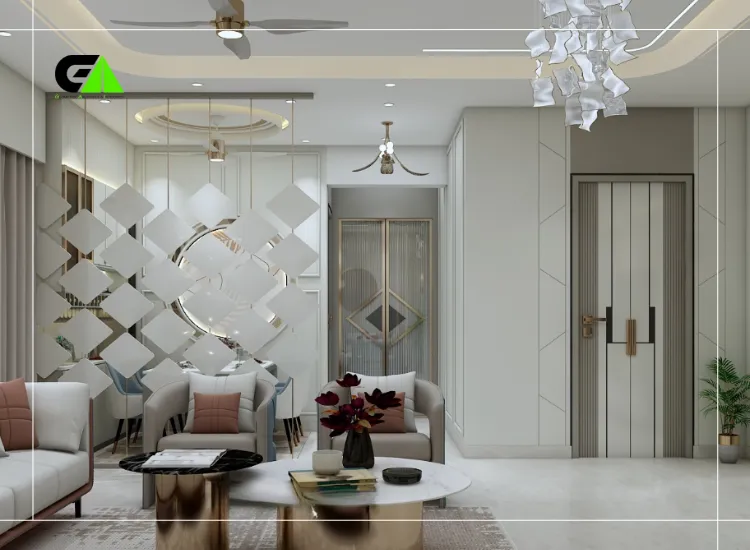
Utilize Mirrors
Utilizing mirrors can be a fantastic way to make a small living room look bigger. Mirrors reflect light and create the illusion of more space. They can transform a cramped room into an airy and bright area. Let’s explore how you can use mirrors effectively.
Placement Of Mirrors
The placement of mirrors is crucial. Positioning them opposite windows can reflect natural light. This brightens up the room and makes it feel more open. Another great spot is behind furniture. Placing a mirror behind a sofa or a table can create depth.
You can also hang mirrors on walls where they can reflect interesting objects. This adds visual interest. Avoid placing mirrors in cluttered areas. Instead, use them to reflect clean and open spaces.
Types Of Mirrors
Different types of mirrors can have different effects. Large wall mirrors can create the illusion of an extended wall. They are perfect for small living rooms. Smaller decorative mirrors can be grouped together. This adds style and still helps to open up the space.
You can also use mirrored furniture. A mirrored coffee table or cabinet can reflect light and surroundings. This makes the room look more spacious. Choose the right type of mirror to match your room’s style.
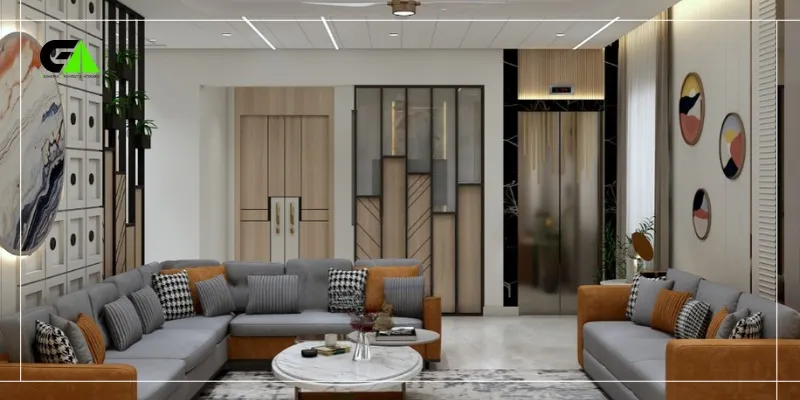
Maximize Natural Light
Maximizing natural light can transform a small living room. It makes the space feel open and airy. Natural light can create an illusion of more space. Follow these tips to make the most of the light you have.
You may like it: Importance of Lighting in Interior Design
Window Treatments
Choose light and airy window treatments for your living room. Heavy curtains can block natural light. Opt for sheer or light-colored curtains. They allow light to filter through while providing privacy.
Consider using blinds that can be easily adjusted. This way, you can control the amount of light entering the room. For a minimalist look, use roman shades. They are sleek and do not take up much space.
You may like it: Living Room Lighting Ideas | Transform Your Living Room
Furniture Placement
Proper furniture placement can help maximize natural light. Avoid placing large furniture items in front of windows. This can block light from entering the room.
Use low-profile furniture to keep the room open. Sofas with low backs and armless chairs can help. They do not obstruct the flow of light.
Reflective surfaces can also enhance natural light. Consider adding mirrors opposite windows. They reflect light and make the room appear larger.
|
Tips |
Details |
|---|---|
|
Light Curtains |
Sheer or light-colored curtains allow light to filter through. |
|
Blinds |
Adjustable blinds control light without taking up space. |
|
Low Furniture |
Low-profile furniture keeps the room open and airy. |
|
Mirrors |
Mirrors opposite windows reflect light and create an illusion of space. |
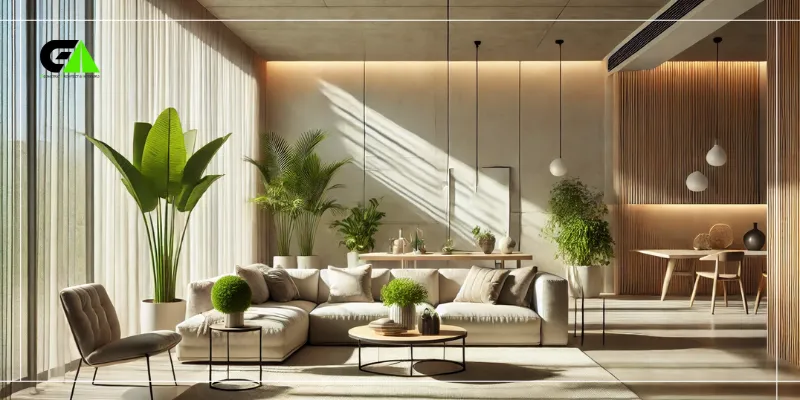
Multi-functional Furniture
Multi-functional furniture can transform a small living room. These pieces serve more than one purpose, saving space and adding functionality. They help create a more open and organized environment. Here are some tips on using multi-functional furniture in your living room.
Convertible Pieces
Convertible furniture changes form to serve different needs. A sofa bed is a great example. Use it as a couch during the day and a bed at night. Another option is a coffee table that lifts to become a dining table. These pieces provide flexibility and save space.
Storage Solutions
Furniture with built-in storage keeps the room tidy. An ottoman with storage inside can hold blankets or magazines. A bookshelf with a fold-out desk offers a work space and storage in one. These solutions help keep clutter at bay.
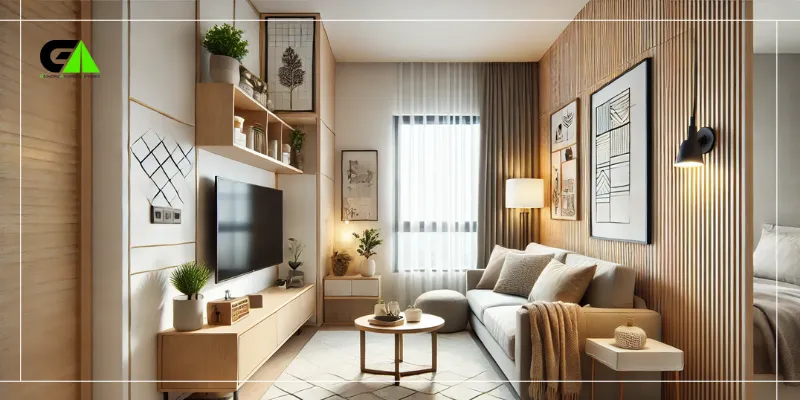
Vertical Space Utilization
Maximizing vertical space is a smart way to make a small living room look bigger. It draws the eyes upward, creating an illusion of height. This technique can transform a cramped space into a cozy, open area.
Shelving Ideas
Install floating shelves on the walls. They provide storage without taking up floor space. Use them to display books, plants, or decorative items. Choose a color that blends with the wall to keep the look seamless.
Consider built-in shelves. They can fit into nooks and corners. Built-ins make use of every available inch, giving a custom look. You can also add baskets or boxes to store smaller items.
Tall Furniture
Opt for tall furniture pieces. A high bookshelf or tall cabinet adds storage and draws the eye up. This makes the room feel taller and more spacious.
A tall mirror is another good choice. Place it strategically to reflect light and expand the room visually. Mirrors create depth and make the space feel airy.
Choose furniture with legs. Raised furniture exposes more floor space, creating an illusion of openness. A tall-legged sofa or chair can make the room look less cluttered.
You may like it: Living Room Interior Design Trends in 2025
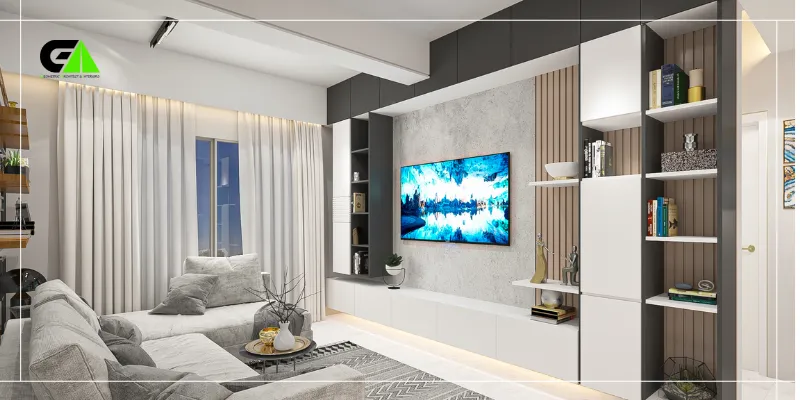
Declutter Regularly
Maintaining a small living room can be challenging. Regular decluttering can make a significant difference. Clutter can make spaces feel cramped and uninviting. By keeping your living area tidy, you can create a more open and serene environment.
Minimalist Approach
Adopting a minimalist approach helps reduce visual clutter. Stick to essential furniture and decor. Choose items that serve more than one purpose. For example, a coffee table with storage can be both practical and stylish.
Keep decorations simple. Display only a few pieces of artwork or photos. Avoid overcrowding shelves and tables. Less is more in a small space.
Organizing Tips
Effective organization is key to maintaining a clutter-free living room. Use storage solutions that blend with your decor. Baskets, bins, and boxes can be both functional and attractive.
Consider using the vertical space. Wall-mounted shelves and cabinets are excellent for storing items without taking up floor space. Labeling your storage can also help you find things quickly and keep everything in its place.
Make it a habit to tidy up daily. Spend a few minutes each day putting things away. This can prevent clutter from building up and keep your living room looking spacious.
|
Tip |
Description |
|---|---|
|
Use Multi-Functional Furniture |
Choose items that offer additional storage. |
|
Limit Decor |
Keep decorations to a minimum to reduce clutter. |
|
Vertical Storage |
Utilize wall-mounted shelves to save floor space. |
|
Daily Tidying |
Spend a few minutes each day organizing. |
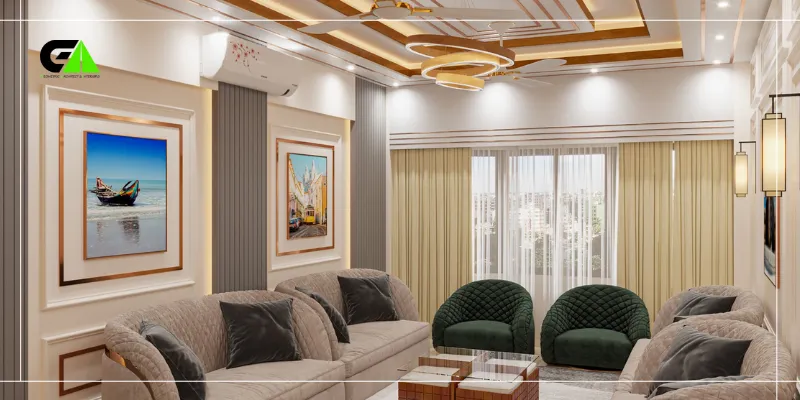
Strategic Furniture Arrangement
Arranging furniture strategically can transform a small living room into a more spacious area. Thoughtful placement can help maximize the space and enhance the room’s flow. Here are some tips to make your small living room look bigger through strategic furniture arrangement.
Creating Pathways
Ensure you create clear pathways for movement. Open pathways make a room feel larger and prevent the space from feeling cramped. For instance, place the sofa against the wall to free up central space. This setup ensures there is a flow from one side of the room to the other.
Use small, movable furniture like ottomans or chairs. You can easily rearrange them to create more space when needed. A coffee table with wheels is also a good option. It adds flexibility and can be moved to create more pathways.
Balancing Proportions
Balancing the proportions of your furniture is crucial. Large, bulky pieces can overwhelm a small room. Opt for furniture that fits the scale of the room. For example, a loveseat instead of a full-size sofa can create more space.
Use multi-functional furniture to save space. A sofa bed or a coffee table with storage can help maintain balance. They provide extra utility without taking up additional space.
Incorporate vertical storage solutions. Tall shelves and cabinets draw the eye upward, making the room feel taller. This technique helps balance the room’s proportions and adds visual interest.
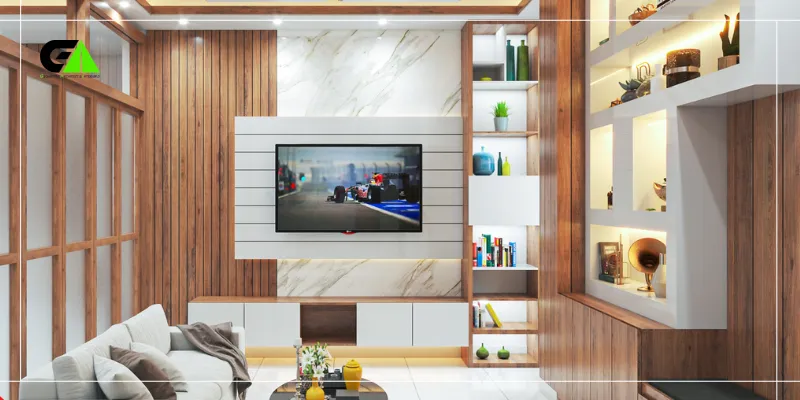
Use Rugs To Define Spaces
Creating a spacious feel in a small living room can be tricky. One effective strategy is to use rugs to define spaces. Rugs can visually separate different areas, making your room appear larger and more organized. This method not only adds comfort but also enhances the aesthetic appeal of your living space.
Choosing The Right Size
Choosing the correct rug size is crucial. A rug that is too small can make your living room feel disjointed and cramped. On the other hand, a rug that is too large can overwhelm the space.
To get the perfect size, measure your seating area first. A good rule of thumb is to select a rug that is large enough to fit under all the main furniture pieces, or at least the front legs of your sofa and chairs. This will help to anchor the furniture and create a unified look.
Layering Techniques
Layering rugs can add depth and texture to your living room. This technique involves placing one rug on top of another. Start with a larger, neutral rug as the base. Then, add a smaller, more colorful or patterned rug on top.
Layering can also help define different zones within a small space. For example, you can place a rug under the coffee table to create a cozy seating area. Then, use a different rug under the dining table to distinguish the dining space.
Here are some layering tips:
-
Use contrasting colors and patterns to add visual interest.
-
Ensure the top rug is smaller than the base rug.
-
Experiment with different textures for a unique look.
Layering rugs is a simple yet effective way to enhance the visual appeal and functionality of your small living room.
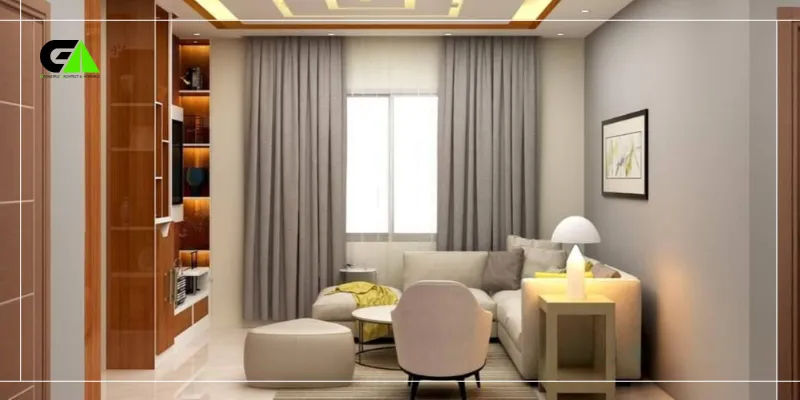
Incorporate Transparent Furniture
Furnishing a small living room can be a challenge. Transparent furniture can help. These pieces offer a stylish solution. They create an illusion of more space. They blend seamlessly with any decor. Let’s explore how to use transparent furniture effectively.
Acrylic And Glass Pieces
Acrylic and glass furniture are your best friends in a small living room. These materials allow light to pass through. This makes the room feel open and airy. A glass coffee table or acrylic chairs work well. They add elegance without overwhelming the space.
Visual Continuity
Transparent furniture helps maintain visual continuity. It reduces visual clutter. The eye moves smoothly across the room. This creates a sense of space. Transparent shelves or side tables can be useful. They offer storage without breaking the visual flow.
Transparent furniture not only looks stylish but also serves a practical purpose. It makes a small living room feel bigger. Try adding a few pieces to see the difference. Your living room will look more spacious and inviting.
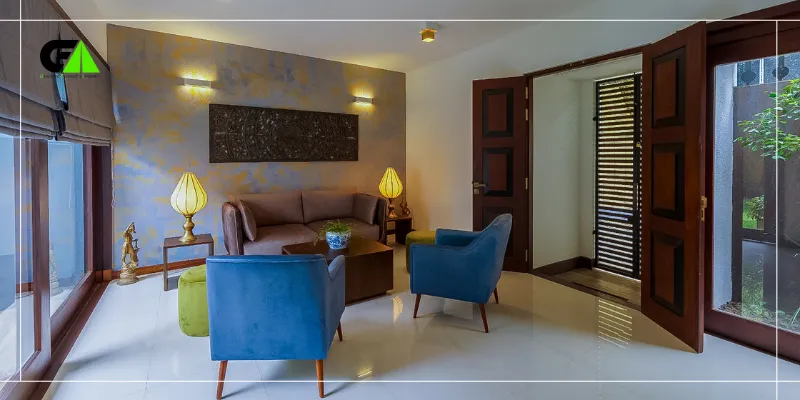
Embrace Vertical Patterns
Making a small living room look bigger can be a challenge. One effective way is to embrace vertical patterns. Vertical lines draw the eye upwards, creating the illusion of a taller space. This technique can be applied in various ways, including through the use of wallpapers, textures, and curtains.
Wallpapers And Textures
Using vertical patterns on your walls can make a big difference. Choose wallpapers with vertical stripes or patterns. They will elongate your walls visually. Textured wallpapers with vertical elements can also achieve this effect. For instance, a wallpaper with vertical ridges adds both texture and height. It’s a simple way to transform your living room.
Curtain Choices
Choosing the right curtains is crucial. Opt for long curtains that hang from the ceiling to the floor. This draws the eye upward, making the room seem taller. Vertical patterns on the curtains can enhance this effect. Avoid heavy drapes as they can overwhelm the space. Instead, go for light fabrics that allow natural light to filter through. This keeps the room feeling airy and spacious.
|
Element |
Recommendation |
|---|---|
|
Wallpapers |
Vertical stripes or textured patterns |
|
Curtains |
Long, light fabrics with vertical patterns |
In summary, embracing vertical patterns can greatly impact the perceived size of your small living room. Use this simple trick to make your space feel larger and more inviting.
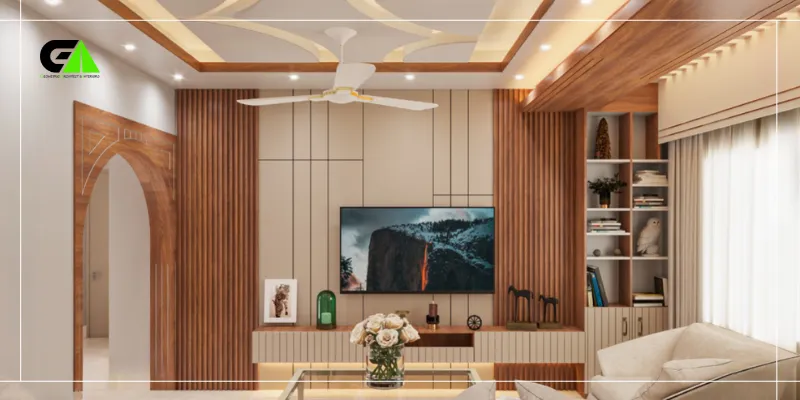
Frequently Asked Questions
How Can I Make A Small Living Room Look Bigger?
Use light colors, add mirrors, and choose multi-functional furniture. Declutter and keep the space organized.
What Colors Make A Small Room Look Bigger?
Light colors like whites, pastels, and neutrals create an illusion of more space. They reflect light well.
Can Mirrors Make A Small Living Room Look Bigger?
Yes, mirrors reflect light and create a sense of depth. Place them strategically for best results.
What Type Of Furniture Is Best For Small Living Rooms?
Choose multi-functional furniture like sofa beds and storage ottomans. Opt for furniture with exposed legs.
Conclusion
Transforming a small living room into a spacious haven is achievable. Use these tips to create a more open and inviting space. Small adjustments can make a significant difference. Play with colors, furniture, and light to enhance the room’s feel.
Try arranging furniture smartly and embrace minimalism. Don’t forget the power of mirrors and multi-functional pieces. A cozy and larger-looking living room awaits. Experiment and enjoy the transformation. Your small space can look bigger and more welcoming with these simple tricks.
Happy decorating!

